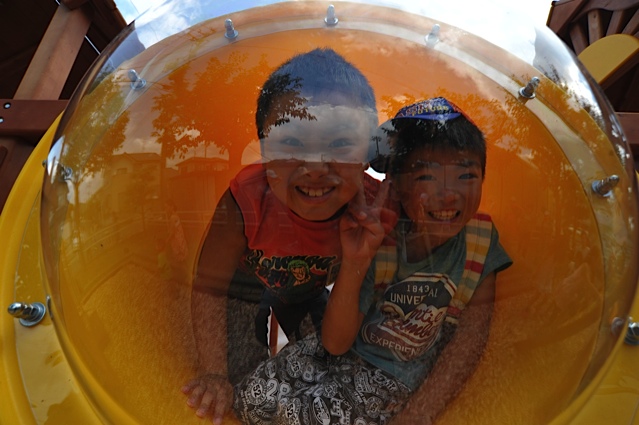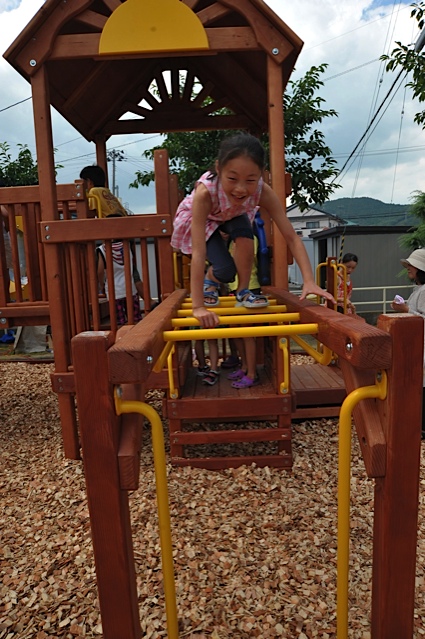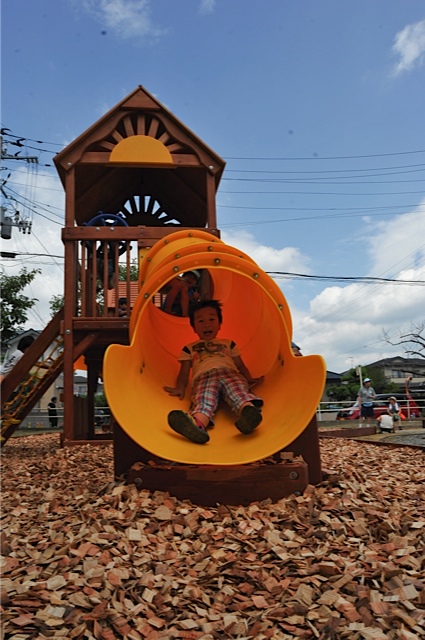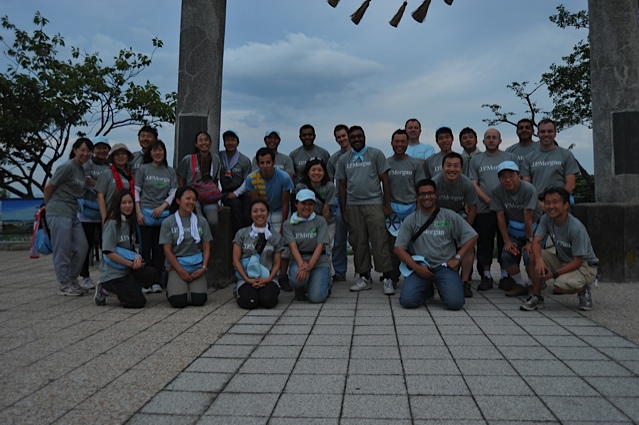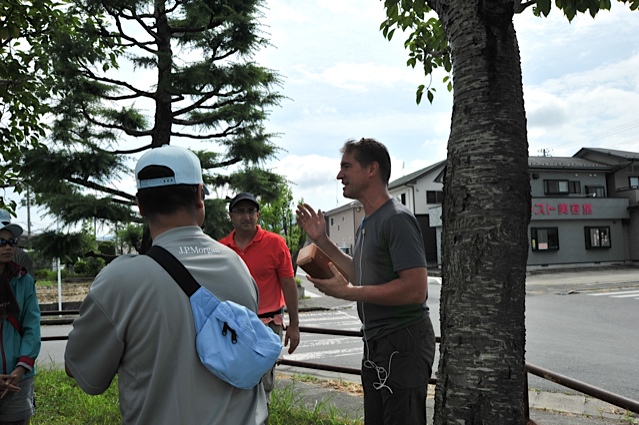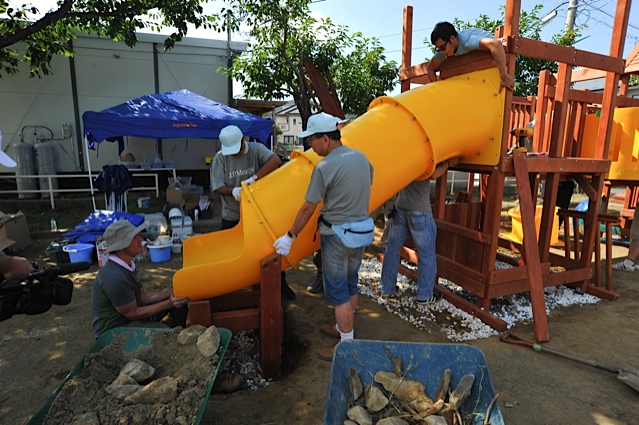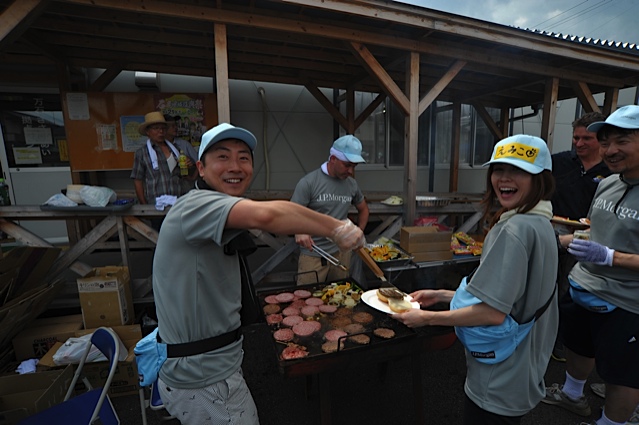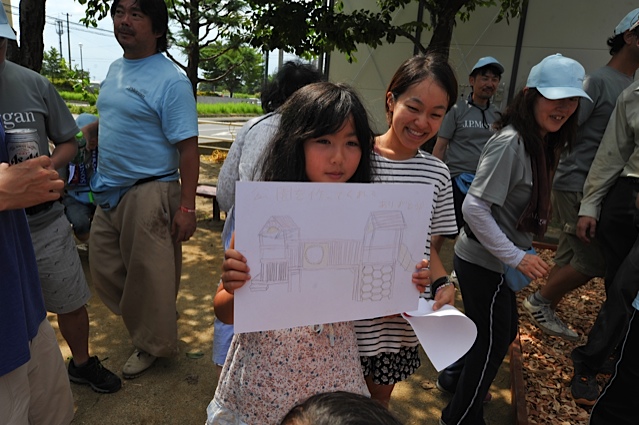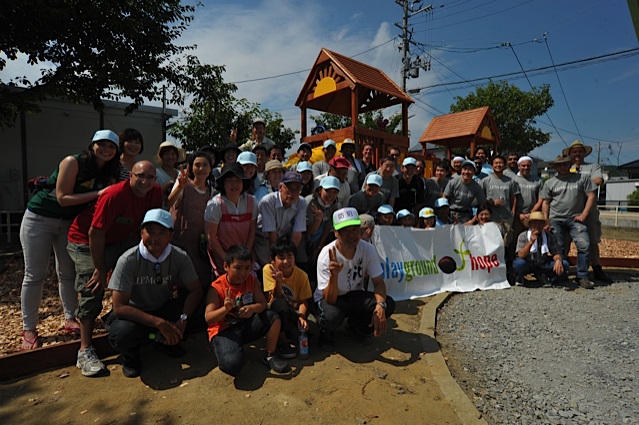By Ron Choi
 Figure 1. The completed playground in Watanoha, Ishinomaki.
Figure 1. The completed playground in Watanoha, Ishinomaki.
On 25th of August, 2013, something magical happened in Ishinomaki, Miyagi prefecture, Japan. Children’s laughter echoed through out the park which only short time ago was a decrepit half a century-old premise overrun with weeds. There were many nearby residents soaking in the festive mood that has completely taken over the neighborhood. These grownups and elderly from kasetsu jyutaku (temporary housing compounds) joined an army volunteers to celebrate the re-opening of their only park. This was Watanoha, Ishinomaki, one of the most devastated towns in all of Japan during the unprecedented calamity of Great East Japan Earthquake. The city of Ishinomaki had lost more than 3000 residents to the tsunami. Of 150,000 residents nearly a third of them reside in 147 still-operating temporary housing compounds even after two and a half years. But there they were, clapping their hands and cheering the volunteers from J.P. Morgan and its NPO partners from NADIA, Playground of Hope (PoH), and It’s Not Just Mud (INJM).
Figure 2. This is why we do it.
It all started with a chance meeting at another temporary housing compound in nearby town of Minamisakai, Ishinomaki in November of 2012. There I met Michael Anop from Playground of Hope. He started building these playgrounds in April, 2012, about a year after the tsunami. Michael had not done a volunteer work in his life, but the images of devastation from the tsunami in Tohoku (Northeast) area really moved him. He packed up and drove up north to help the region start recovering from the disaster. He continued to go up week after week to various towns in Iwate, Miyagi and Fukushima prefectures. After a while he started noticing a critical need that was not at all being addressed. The temporary housing units were built on city properties in a desperate attempt to provide the absolutely minimum living space for those in the shelters. This invariably meant that these units were built on each city’s parks. Since all park premises were taken up by these temporary residences, the children living the in these units had nowhere to play. He saw kids playing with wooden sticks in parking lots. He had an epiphany. He needs to build playgrounds for these kids.
Figure 3. This is why we do it.
The playground in Minamisakai temporary housing compound, the largest of many in Ishinomaki, was paid for by the donation money raised by Tokyo International School moms. My wife was one of the moms. Our entire family of five went up to Ishinomaki to attend the opening ceremony. It was magical. The kids went bonkers. They finally had a place they can climb, slide down, and hang on to safely. The play deficit these kids experienced for nearly two years left them maladjusted and unhappy. Now they had a proper place to play. And play they did. I told Michael, “This is absolutely amazing. I’d like to help. We need to chat.”
Figure 4. A group photo of the J.P. Morgan volunteers on top of the hills of Kadonowakicho, Ishinomaki.
J.P. Morgan made a significant amount of donations to build playgrounds in Tohoku region. It was the largest donation NADIA ever received. At the same time, the city of Ishinomaki asked for an entire park next to temporary housing compounds in Watanoha area to be renovated. Up until then, most of the playgrounds were built on nursery and preschools or on the premise of temporary housing compounds. Building a play set is one thing, rebuilding an entire park is a challenge of completely different scale. It was the largest project ever for the three NPOs involved. We decided to take it on. NADIA will partner with J.P. Morgan, PoH, and INJM to bring the project to fruition.
Figure 5. Michael Anop of Playground of Hope and his long-time partner, Neil Rosenblatt, giving instructions to our volunteers.
27 J.P. Morgan volunteers from Tokyo office joined four core members from NADIA on a six-hour bus ride to Ishinomaki on Friday evening, 23rd of August. There, they were joined by PoH and INJM members on site. PoH staff started planning three months in advance. Contractors were signed to put in a gazebo and prepare the grounds for the build. A new water fountain was put in. By the time the volunteers showed up at the park, only one weekend’s worth of work was left. Michael and his long time partner, Neil Rosenblatt, ran the weekend operation like army generals. The entire operation was divided into 60 clearly explained tasks. The teamwork and spirit exhibited during that weekend’s operation were impressive. They nearly finished a weekend’s worth of work on the first day. A play set was built, sandpit was cleaned out, rusted metal fences around the park were sanded down and freshly painted. Flowers were planted. Woodchips were laid down around the playground to prevent injury.
Figure 6. Michael Anop and Jamie El-Bana, of It’s Not Just Mud, putting in the slide with our volunteers.
The residents of the temporary housing compound were quite excited at the news of park renovation. They passed around hats to gather whatever they could to throw a BBQ party in celebration of the park re-opening. These folks started showing up early morning on Sunday well before the ceremony was to be held. The kids waited anxiously for the opening ceremony to be finished. We had indoor children’s activities – origami, chocolate fondue-making, etc. in the community center next to the park. We made giant soap bubbles with the children. There were smiles all around. People started walking up from the streets to thank us. A grandmother showed up with a small child whose parents perished in the tsunami to thank one of the volunteers for the playground. She said she’s too senile to even carry the child, but now she has a place for her to bring the child for quality playtime. That brought the volunteers to tears. Another elderly lady walked up to tell another volunteer how grateful she was to see something like this. She said the playground was amazing. She had no idea the volunteer did not speak Japanese. One of the Japanese volunteers informed her she was talking to a person who doesn’t understand her language. She said it doesn’t matter. She spoke to him heart to heart.
Figure 7. Our new lovely playground waiting for kids to arrive.
After obligatory opening speech, kids ran to the playground and did what children do at a playground. There were giggles, laughter, screams and bright smiles. These children will have a happy memory to cherish when they grow up. We have made a difference. It was magical.
Figure 8. We had 1000 yakitori skewers, 150 hamburger patties, and 600 sausages. Good thing because hundreds of people showed up for the festivities.
We will be building many more of these playgrounds in the Tohoku area. We may be able hit the target of building the 20th Playground of Hope that Michael Anop set as a target for 2013. J.P. Morgan volunteers will be making another playground build trip in September 2013 to Minamisanriku in Miyagi prefecture. There will be many more after. Michael has an ambitious plan to build 40 more in 2014.
Figure 9. Many children presented us with their drawings. Here she drew the playground we built and wrote a caption saying, “Thank you for building us a playground.”
Figure 10. We sincerely thank our volunteers for their hard work in rebuilding the park.

